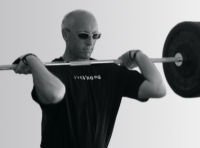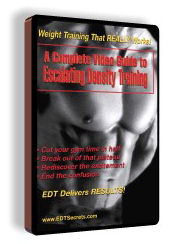|
Since the inception of
the
Escalating Density Training system,
one of the most common inquiries we receive
at the office is "When
are you going to write about EDT for fat
loss?"
How about right now?
As it turns out, EDT is perhaps the simplest
and most effective training technique
available for body composition training. I
was recently talking to my colleague Alwyn
Cosgrove, owner of Results Fitness Training
in Newhall, California has been using
EDT-inspired training programs to facilitate
rapid losses in bodyfat with his clients for
several months now.
In fact, Alwyn claims an average loss of 2%
bodyfat per month with no dietary changes at
all. However, there is a price to be paid
for quick results, and this program does
exact a heavy toll. Cosgrove joking refers
to it as "Rambo training" it’s not for
wussies. I agree, but at the same time, this
is about as fun as hard work can be. Have a
look:
The Program
This EDT cycle is simple, brief and yet
quite brutal. You’ll perform (3) 15-Minute
"PR Zones" where you’ll attempt to
accumulate as many total reps as possible
and then improve upon that number every
workout (see "EDT Loading Parameters" for
more details).
Each and every workout you know how long
it’ll last and you also know exactly what
you need to accomplish. It’s that simple.
Here’s your program, make exercise
substitutions if equipment or injury
restrictions warrant.
Monday
First PR Zone (15 Minutes)
A-1: Chins
A-2: Hack Squat
Rest: 5 Minutes
Second PR Zone (15 Minutes)
A-1: Rows
A-2: Seated Leg Curl
Rest: 5 Minutes
Third PR Zone (15 Minutes)
A-1: Overhead Press Machine
A-2: Incline Board Sit-Ups
Wednesday
First PR Zone (15 Minutes)
A-1: Dips
A-2: Back Extension
Rest: 5 Minutes
Second PR Zone (15 Minutes)
A-1: Incline Press Machine
A-2: Leg Extension
Rest: 5 Minutes
Third PR Zone (15 Minutes)
A-1: Flat Dumbbell Bench Press
A-2: Reverse Trunk Twist on Ball
Friday
First PR Zone (15 Minutes)
A-1: Dumbbell Deadlift
A-2: Push Press
Rest: 5 Minutes
Second PR Zone (15 Minutes)
A-1: Preacher Curl
A-2: Lying Dumbbell Triceps Extension
Rest: 5 Minutes
Third PR Zone (15 Minutes)
A-1: Standing Lateral Raise
A-2: Prone Ball Roll
COSGROVE:
Note that you can also reduce the rest
periods between PR zones thereby further
increasing the density. I also prefer to
have a bigger rep "buffer." In regular EDT,
I allow 20% more reps before I increase the
loads.
In Fat Loss EDT, I don’t increase the loads
until you perform 30% more reps. I think the
higher volume helps with fat loss (this
assumes a good load selection initially).
Another rule I use is that the eccentric
phase should be controlled, the concentric
should be accelerative.
EDT Loading Parameters
For those not yet familiar with EDT’s unique
loading parameters, here’s the nuts and
bolts:
Escalating Density Training is based on the
concept of doing more and more work from
workout to workout. Therefore, it’s critical
that your exercise biomechanics (i.e.,
technique) is consistent on every workout.
If you perform strict curls on one workout
and loose form the next, you aren’t really
doing more work (for the arms at least!)
-
I recommend 10-15 minutes of light to
moderate cardio, followed by 10-15
minutes of light stretching on ìoffî
days for the purpose of promoting active
recovery and reducing soreness.
-
Each workout in this cycle consists of
(3) PR Zones of 15-minutes duration
separated by a short (5-minute) rest
periods. In each PR Zone, you’ll
generally perform two exercises, for a
total of 3-4 exercises per workout.
-
In each PR Zone, you’ll typically
perform two antagonistic exercises in
alternating fashion, back and forth,
using the same weight for all sets,
until the PR Zone has elapsed.
-
After warming up the first exercise(s),
select a load that approximates a 10RM
for each exercise. Ideally, the weight
used for each exercise should be equally
difficult.
Sets/Reps/Rest Intervals:
This is where EDT is truly unique. Most
people will find it most productive to do
higher repetition (but not maximal effort)
sets and shorter rests at the beginning, and
then gradually progress to fewer reps per
set and longer rest intervals as fatigue
accumulates.
|
|
As an example, you might begin by performing sets of
5 with very short (10-15 second) rests.
As you begin to fatigue, you’ll increase your rest
intervals as you drop down to sets of 4, then 2, and
as the time limit approaches, you might crank out a
few singles in an effort of accomplish as many
repetitions as possible in the time allotted. |
NOTE: Do not perform early sets to
failure, or even near failure. My
recommended starting point is to do 1/2 of
what is possible (e.g., 5 reps with a 10RM
weight) at the beginning of the time frame.
As the time limit approaches however, you’ll
find yourself working at or near failure as
you attempt to break your rep record.
Progression: Each time you repeat the
workout; your objective is to simply perform
more total repetitions in the same time
frame. As soon as you can increase the total
number of reps by 20 percent or more, start
the next workout with 5 percent more weight
and start over. Similarly, if you manage to
improve upon your last performance (for the
same workout) by 40 percent, then you’ll
increase your weights by 10 percent on the
next workout.
PROGRESS ACCELERATION TIPS:
I like amino acids as the post workout meal
– an hour later I have a shake with fiber
when training for fat loss.
Aerobics: avoid like the plague –
they cause you to lose muscle, and they help
you to become more efficient at burning fat.
So how would you like your fat burning
machinery to get smaller and more efficient
when you are trying to lose fat ? Thought
so.
For the EXTREME RAMBO HARDCORE ADDICT:
Do EDT using hybrid lifts – see below.
Another very cool yet brutal tip is to do
TWO 15 min periods in the workout but
perform TWO EDT workouts per day. Brutal but
it’ll carve you up.
Day One:
First PR Zone (15 Minutes)
A1 Alternating max lunge
A2 Seated Cable Rows
Second PR Zone (15 Minutes)
B1 Step Up
B2 Push up-prone tuck combo
Third PR Zone (15 Minutes)
C1 DB Squat and Press
C2 Close Grip Pulldown
Day Two:
First PR Zone (15 Minutes)
A1 Bulgarian Split Squat
A2 Push Press
Second PR Zone (15 Minutes)
B1 SHELC
B2 Seated Row to neck
Second PR Zone (15 Minutes)
C1 Good morning squat hybrid
C2 Incline Db Press
Day Three :
First PR Zone (15 Minutes)
A1 Deadlift
A2 Pullover
Second PR Zone (15 Minutes)
B1 Lateral Lunge and touch
B2 Arnold Press
Third PR Zone (15 Minutes)
C1 DB Swiss Ball Crunch
C2 Bent Over DB Row
Fuel For EDT
To maximize the effectiveness of this EDT
fat-loss program, employ the following
nutritional strategies:
1) Reduce consumption of refined
carbohydrate (breads, pastas, white rice,
potatoes, grains, cakes, cookies, etc.) to a
bare minimum, especially later in the day.
2) Virtually all meals should contain a
fiber source, expect for post-workout meals,
which should ideally be a fast-absorbing
protein/carb shake. Check out a cool product
called Fiber Smart. This is a unique,
dietary fiber made from flax seeds and other
top quality ingredients to support proper
function and health. It also contains
Acidophilus and Bifidus to promote a health
bacterial balance and amino acids to support
a healthy digestive lining.
2) Eat every 3 hours for a total of 5 to 6
meals per day. No exceptions. Schedule meals
as if they were appointments with yourself,
because that’s what they really are when you
think about it.
3) Calculate or estimate your lean body mass
(total weight - fat weight) and eat one gram
of animal-source protein per pound of lean
bodyweight per day, divided into 5 or 6
meals. For an individual who weighs 200
pounds and is 15% body fat, this would mean
170 grams per day, which would equate to 5
meals containing 34 grams of protein per
meal.
4) Hydrate! My recommended water intake is
60 percent of your bodyweight in pounds,
converted to ounces, per day. For example,
if you weigh 150 pounds, drink 90 ounces of
water per day.
5) Watch out for "hidden" sources of fat and
sodium such as various salad dressings and
condiments.
6) Educate yourself on the caloric value of
what you eat. If you’re not losing weight
(fat) you’ll need to eat slightly less
calories, and/or increase caloric
expenditure (via exercise). There may be
some trial and error at first as you learn
more about how many calories you’ll need to
create an energy deficit. COSGROVE:
this is key. Violate this rule and you are
toast.
7) Develop strategies to cope with difficult
situations, such as family get-togethers and
going out to eat. COSGROVE: Fast
food? Yesó it’s called grilled chicken
sandwich. Fries, no.
8) Virtually all breakfast cereals are to be
avoided - they almost always contain high
levels of calories, sugar and non-existent
protein and fiber content - the worst
possible type of food. COSGROVE: the
only cereal you can have is oatmeal. Nothing
else.
9) Some saturated fat is OK, but it’s easy
to take in more than you realize - be
careful with salad dressings, condiments,
grilled meats, fried foods, Chinese food,
gravies, etc.
10) Stop analyzing everything to death and
get down to basics - it’s not that difficult
to figure out how to eat right. Which brings
us to...
11) Staley on "simplexity": OK, let’s get
down to brass tacks here - EAT LESS! I’m
often asked about the fat loss value of
various foods like grapefruit, cider
vinegar, etc. My patented response is "Any
food will make you lose weight- if you eat
too little of it."
A little trick is in order here - the next
time you feel hungry, instead of giving in
to it and feeling deprived, tell yourself
"OK- this is good - it’s a sign that I’m
doing the right thing." Trick yourself into
believing that being hungry is desirable.
12) Here’s what Cosgrove has to say about
cheating:
If you cheat: DO NOT, I repeat DO NOT
change your next meal. I see many clients
who overeat at one meal and then under eat
at the next meal as a kind of "payback." All
you did now was screw up TWO meals.
If you cheat: get right back on
track. A lot of people think after cheating
- I’ve blown it - so I might as well REALLY
blow it! Let me ask you - if you get a flat
tire do you get out of your car and slash
the other three? Hey, you have a flat tire -
might as well have four, right?
13) Cosgrove on hunger: Hunger is a
sign that your body is lacking in energy. At
this point your body will use stored fat as
a fuel source. It’s a good thing. While I
agree with Dr. Eric Serrano that calories
are not created equal - it’s tough to argue
that eating less calories will cause
anything other than weight loss. It’s the
law of thermodynamics. |




